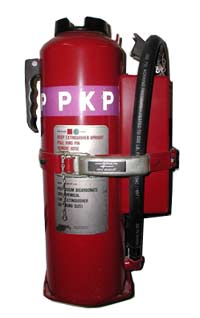Bicarbonate Of Potassium on:
[Wikipedia]
[Google]
[Amazon]
Potassium bicarbonate ( IUPAC name: potassium hydrogencarbonate, also known as potassium acid carbonate) is the 
Potassium Bicarbonate Handbook
OMRI Potassium Bicarbonate
Safety Data sheet - potassium bicarbonate
* {{Authority control Potassium compounds Acid salts Fire suppression agents
inorganic compound
In chemistry, an inorganic compound is typically a chemical compound that lacks carbon–hydrogen bonds, that is, a compound that is not an organic compound. The study of inorganic compounds is a subfield of chemistry known as '' inorganic chemist ...
with the chemical formula KHCO3. It is a white solid.

Production and reactivity
It is manufactured by treating an aqueous solution of potassium carbonate withcarbon dioxide
Carbon dioxide (chemical formula ) is a chemical compound made up of molecules that each have one carbon atom covalently double bonded to two oxygen atoms. It is found in the gas state at room temperature. In the air, carbon dioxide is transpar ...
:
:K2CO3 + CO2 + H2O → 2 KHCO3
Decomposition of the bicarbonate occurs between :
:2 KHCO3 → K2CO3 + CO2 + H2O
This reaction is employed to prepare high purity potassium carbonate.
Uses
Food and drink
This compound is a source ofcarbon dioxide
Carbon dioxide (chemical formula ) is a chemical compound made up of molecules that each have one carbon atom covalently double bonded to two oxygen atoms. It is found in the gas state at room temperature. In the air, carbon dioxide is transpar ...
for leavening in baking. It can substitute for baking soda (sodium bicarbonate) for those with a low-sodium diet, and it is an ingredient in low-sodium baking powders.
As an inexpensive, nontoxic base, it is widely used in diverse application to regulate pH or as a reagent
In chemistry, a reagent ( ) or analytical reagent is a substance or compound added to a system to cause a chemical reaction, or test if one occurs. The terms ''reactant'' and ''reagent'' are often used interchangeably, but reactant specifies a ...
. Examples include as buffering agent in medications, an additive in winemaking
Winemaking or vinification is the production of wine, starting with the selection of the fruit, its fermentation into alcohol, and the bottling of the finished liquid. The history of wine-making stretches over millennia. The science of wine and ...
.
Potassium bicarbonate is often found added to club soda to improve taste, and to soften the effect of effervescence.
Fire extinguishers
Potassium bicarbonate is used as a fire suppression agent ("BC dry chemical") in some dry chemical fire extinguishers, as the principal component of thePurple-K Purple-K, also known as PKP, is a dry-chemical fire suppression agent used in some dry chemical fire extinguishers. It is the second most effective dry chemical in fighting class B (flammable liquid) fires after Monnex (potassium allophanate), and ...
dry chemical, and in some applications of condensed aerosol fire suppression. It is the only dry chemical fire suppression agent recognized by the U.S. National Fire Protection Association
The National Fire Protection Association (NFPA) is an international nonprofit organization devoted to eliminating death, injury, property and economic loss due to fire, electrical and related hazards. As of 2018, the NFPA claims to have 50,000 mem ...
for firefighting at airport crash rescue sites. It is about twice as effective in fire suppression as sodium bicarbonate
Sodium bicarbonate (IUPAC name: sodium hydrogencarbonate), commonly known as baking soda or bicarbonate of soda, is a chemical compound with the formula NaHCO3. It is a salt composed of a sodium cation ( Na+) and a bicarbonate anion ( HCO3−) ...
.
Agriculture
Potassium bicarbonate has widespread use in crops, especially forneutralizing
A neutralizing antibody (NAb) is an antibody that defends a cell from a pathogen or infectious particle by neutralizing any effect it has biologically. Neutralization renders the particle no longer infectious or pathogenic.
Neutralizing antibod ...
acidic soil.
Potassium bicarbonate is an effective fungicide
Fungicides are biocidal chemical compounds or biological organisms used to kill parasitic fungi or their spores. A fungistatic inhibits their growth. Fungi can cause serious damage in agriculture, resulting in critical losses of yield, quality, ...
against powdery mildew and apple scab, allowed for use in organic farming.
Potassium bicarbonate is a contact killer for Spanish moss
Spanish moss (''Tillandsia usneoides'') is an epiphytic flowering plant that often grows upon large trees in tropical and subtropical climates. It is native to much of Mexico, Bermuda, the Bahamas, Central America, South America, the Southern Uni ...
when mixed 1/4 cup per gallon.
History
The word ''saleratus'', fromLatin
Latin (, or , ) is a classical language belonging to the Italic branch of the Indo-European languages. Latin was originally a dialect spoken in the lower Tiber area (then known as Latium) around present-day Rome, but through the power of the ...
''sal æratus'' meaning "aerated salt", first used in the nineteenth century, refers to both potassium bicarbonate and sodium bicarbonate.
References
External links
Potassium Bicarbonate Handbook
OMRI Potassium Bicarbonate
Safety Data sheet - potassium bicarbonate
* {{Authority control Potassium compounds Acid salts Fire suppression agents